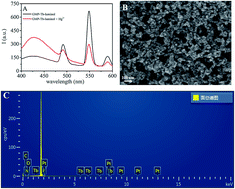Dual luminescent lanthanide coordination polymers for ratiometric sensing and efficient removal of Hg2+†
Abstract
In this work, we report a new fluorescence ratiometric method for Hg2+ assay based on the dual-ligand fluorescent probe GMP–Tb–luminol coordination polymers (CPs), which can be excited at the same wavelength and reveal characteristic luminescence of Tb3+ and luminol with spectrally distinguishable emission peaks. The addition of Hg2+ leads to the decrease of Tb3+ luminescence due to the higher coordination between Hg2+ and GMP, which inhibits energy transfer from GMP to Tb3+. Meanwhile, the fluorescence of luminol increases because of the aggregation-induced emission phenomenon. Therefore, a ratiometric fluorescent sensor for Hg2+ assay can be constructed by measuring the ratio of fluorescence intensity of luminol at 430 nm (I430) to that of Tb3+ at 548 nm (I548). Under the optimal conditions, the fluorescence intensity ratio I430/I548 exhibits a good linear relationship versus the concentration of Hg2+ in the range from 5 nM to 130 μM with a low detection limit of 1.3 nM. Additionally, the probe can also adsorb Hg2+ in water with high efficiency, which makes Hg2+ removal in water possible. The proposed method has been successfully used for the determination of Hg2+ in tap water, indicating its potential applications in the detection of Hg2+ pollution in environmental water.



 Please wait while we load your content...
Please wait while we load your content...